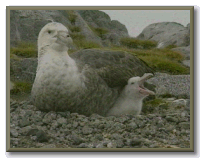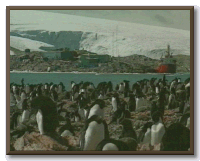Antarctica and the sub-Antarctic islands have been isolated for a long time, and those birds which colonized the areas have done so in the absence of terrestrial predators. Most exhibit a remarkable tameness which permits close observation and study. Communal nesting habits, and in the case of penguins and petrels, extreme adaptation to a pelagic life have left the birds highly vulnerable to the activities of man.
Nesting birds, even penguins in the dense rookeries, are easily disturbed and will desert their nest. This causes a disruption in the orderliness of the colony, fighting and exposing the eggs and chicks to increased predation from skuas and other natural enemies. Giant Petrels, gulls and terns are birds that are easily disturbed.
|
|
|
Already man has caused considerable damage to populations of birds on the sub-Antarctic islands. At about the turn of the century penguins were slaughtered in millions for their oil and other birds exploited for their feathers. At the same time alien animals were introduced, some of which became feral (wild.)
Although the harvest of penguins has ceased, feral cats and rats remain and prey on these ground nesting birds. Grazing animals destroy or modify the vegetation, allowing soil erosion and the loss of cover for the burrowing birds. Fortunately, no introduced predators have become established on the Antarctic continent.
|
|
WANT TO LEARN MORE?
|
|
Websites
• Antarctic petrel: 8 Facts Information including taxonomy of the Antarctic petrel. • South polar skua: 6 Facts Information on the South polar skua includes taxonomy information. • Southern giant-petrel: 9 Facts Facts about the Southern giant-petrel including taxonomy. • Seabirds Information on some of the species of seabirds that breed on the Antarctic continent. • Prehistory: 10 Facts More background information on the prehistory of Antarctica. • Antarctic Adventure 1997 Information on the geography and climate of Antarctica. |
![]()

